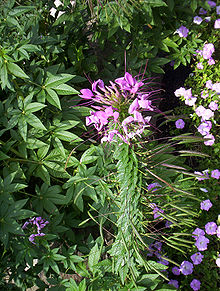- Cleome
-
Cleome Cleome hassleriana Scientific classification Kingdom: Plantae (unranked): Angiosperms (unranked): Eudicots (unranked): Rosids Order: Brassicales Family: Cleomaceae Genus: Cleome
L.Species See text
Cleome is a genus of flowering plants in the family Cleomaceae. Previously it had been placed in family Capparaceae, until DNA studies found the Cleomaceae genera to be more closely related to Brassicaceae than Capparaceae. The APG II system[1] allows for Cleome and the other members of Cleomaceae to be included in Brassicaceae.
The genus sensu stricto includes about 170 species of herbaceous annual or perennial plants and shrubs.[2] The genus has a subcosmopolitan distribution throughout the tropical and warm temperate regions of the world.[2] However a recent DNA study failed to separate Cleome, Podandrogyne and Polanisia from each other, so some taxonomists have abandoned the last two of these genera, treating them as part of Cleome sensu lato; in this case Cleome contains about 275 species, the vast majority of the Cleomaceae.
As a genus it contains species which show a developmental progression from C3 photosynthesis to C4 photosynthesis. This combined with its being a Brassicaceae (and therefore closely related to the model plant species Arabidopsis thaliana) make it an ideal genus in which to study how C4 photosynthesis occurs and how it evolved. Morphological differences that demonstrate the transition from C3 to C4 include C3 species having more veins and larger bundle sheath cells. There are also proteins present in species such as Cleome gynandra which are needed for C4 photosynthesis.[3]
Species of Cleome are commonly known as spiderflowers, spiderplants, spiderweeds, or beeplants.[4][5]
Contents
Selected species
- Cleome aculeata L. , tropical
- Cleome anomala Kunth; neo-tropical
- Cleome arborea Kunth
- Cleome aspera Koen. ex DC.
- Cleome augustinensis (Hochr.) Briq.
- Cleome chilensis DC.
- Cleome cordobensis Eichler ex Griseb.
- Cleome diffusa Banks ex DC.
- Cleome eosina J.F.Macbr.
- Cleome flexuosa F.Dietr.
- Cleome gigantea L.
- Cleome glabra Taub. ex Glaz.
- Cleome guianensis Aubl.
- Cleome gynandra L.
- Cleome hassleriana Chodat
- Cleome herrerae J.F.Macbr.
- Cleome hirta (Klotzsch) Oliv.
- Cleome iberica DC.
- Cleome isomeris Greene
- Cleome lanceolata (Mart. & Zucc.) H.H.Iltis
- Cleome lechleri Eichler
- Cleome lutea Hook.
- Cleome micrantha Desv. ex Ham.
- Cleome monophylla L.
- Cleome multicaulis DC.
- Cleome ornithopodioides L.
- Cleome paludosa Willd. ex Eichler
- Cleome parviflora Kunth
- Cleome pilosa
- Cleome platycarpa Torr.
- Cleome psoraleifolia DC.
- Cleome rubella Burch.
- Cleome rutidosperma DC.
- Cleome serrata Jacq.
- Cleome serrulata Pursh
- Cleome sparsifolia S.Wats.
- Cleome speciosa Raf.
- Cleome spinosa Jacq.
- Cleome stenophylla Klotzsch ex Urban
- Cleome stylosa Eichler
- Cleome titubans Speg.
- Cleome trachycarpa Klotzsch ex Eichler
- Cleome tucumanensis H.H.Iltis
- Cleome violacea L.
- Cleome viridiflora Schreb.
- Cleome viscosa L.
- Cleome werdermannii A. Ernst
Cultivation and uses
Cleome hassleriana (spider flower) is a commonly cultivated garden plant, which can become invasive if attention is not paid to removing it before it can shed its seeds.
Gallery of Cleome species
-
Cleome viscosa at Ananthagiri Hills, in Rangareddy district of Andhra Pradesh, India.
-
Cleome viscosa at Ananthagiri Hills, in Rangareddy district of Andhra Pradesh, India.
-
Cleome monophylla in Keesara, Rangareddy district, Andhra Pradesh, India.
-
Cleome monophylla in Keesara, Rangareddy district, Andhra Pradesh, India.
-
Cleome_hassleriana or Tarenaya_hassleriana[10] in Brescia, Italy.
References
- ^ Stevens, P. F. (2001 onwards) Angiosperm Phylogeny Website: Brassicales.
- ^ a b c Huxley, A., ed. (1992). New RHS Dictionary of Gardening 1: 652-653. Macmillan ISBN 1-56159-001-0.
- ^ Marshall, D.M., Muhaidat, R., Brown, N.J., Liu, Z., Stanley, S., Griffiths, H.G., Sage, R.F., Hibberd, J.M. (2007) Cleome, a genus closely related to Arabidopsis, contains species spanning a developmental progression from C3 to C4 photosynthesis. Plant Journal, 51: 886-896
- ^ Steve L. O’Kane, Jr.. "Cleomaceae: Cleome Family". San Juan College. http://www.sanjuancollege.edu/pages/953.asp. Retrieved July 29, 2011.
- ^ G. J. H. Grubben (2004). Plant Resources of Tropical Africa 2: Vegetables. PROTA. p. 197–198. ISBN 9789057821479. http://books.google.com.ph/books?id=6jrlyOPfr24C&lpg=PP1&hl=en&pg=PA197#v=onepage&q&f=false.
- ^ Germplasm Resources Information Network: Cleome list
- ^ Flora Europaea: Cleome list
- ^ USDA Plants Profile: Cleome list
- ^ Efloras: Cleome search results
- ^ Flora of China 7: 430–431. 2008: Tarenaya Rafinesque

This Brassicales article is a stub. You can help Wikipedia by expanding it.







